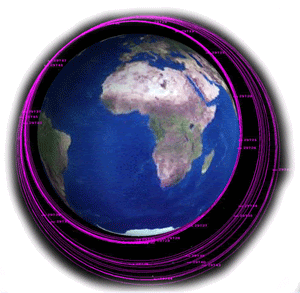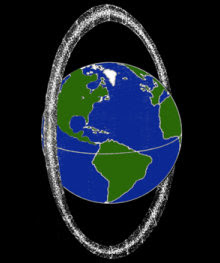China’s ASAT – The Problem With Debris
 The launch path is the heavier purple path closer to the Earth, the intercept point is pretty clear and the threaded looking paths are the initial plots of debris. To give a better feel for what this constitutes, consider the infamous USAF “Needles” experiment or Project West Ford.
The launch path is the heavier purple path closer to the Earth, the intercept point is pretty clear and the threaded looking paths are the initial plots of debris. To give a better feel for what this constitutes, consider the infamous USAF “Needles” experiment or Project West Ford.
At the height of the Cold War in the late 1950s, all international communications were either sent through undersea cables or bounced off of the natural ionosphere. The United States military was concerned that the Soviets (or others) might cut those cables, forcing the unpredictable ionosphere to be the only means of communication with overseas forces. The Space Age had just begun, and the communications satellites we rely on today existed only in the sketches of futurists. Nevertheless, the US Military looked to space to help solve their communications weakness. Their solution was to create an artificial ionosphere. In May 1963, the US Air Force launched 480 million tiny copper needles that briefly created a ring encircling the entire globe. They called it Project West Ford. The engineers behind the project hoped that it would serve as a prototype for two more permanent rings that would forever guarantee their ability to communicate across the globe.
 The West Ford copper needles were each 1.8 cm long and 0.0018 cm in diameter and weighed only 40 micrograms. They were designed to be exactly half of the wavelength of 8000 MHz microwaves. This length would create strong reflections when the microwaves struck the copper needles, in effect making them tiny dipole antennae each repeating in all directions the exact same signal they received. Most of the West Ford dipoles re-entered Earth’s atmosphere sometime around 1970, according to theoretical and observational evidence. The needles slowly drifted down to the Earth’s surface, unscathed by re-entry because of their size (unlike the current mess left on orbit by China).
The West Ford copper needles were each 1.8 cm long and 0.0018 cm in diameter and weighed only 40 micrograms. They were designed to be exactly half of the wavelength of 8000 MHz microwaves. This length would create strong reflections when the microwaves struck the copper needles, in effect making them tiny dipole antennae each repeating in all directions the exact same signal they received. Most of the West Ford dipoles re-entered Earth’s atmosphere sometime around 1970, according to theoretical and observational evidence. The needles slowly drifted down to the Earth’s surface, unscathed by re-entry because of their size (unlike the current mess left on orbit by China).
This was a dangerous, reckless and irresponsible action on the part of China and well deserving of the condemnation it is receiving.
P.S. General Peng has his own web page. On it, he links to a post by a self-described PLA soldier who describes the test as a slap in America’s face to get the US back to the negotiating table on a space demilitarization treaty. Some text with translation: http://chinamatters.blogspot.com/2007/01/view-from-inside-pla-on-chinas-anti.html
P.P.S.
Expensive new U.S. spy satellite not working: sources
Thu Jan 11, 2007 4:39pm ET
By Andrea Shalal-Esa – Exclusive
WASHINGTON (Reuters) – U.S. officials are unable to communicate with an expensive experimental U.S. spy satellite launched last year by the U.S. National Reconnaissance Office (NRO), a defense official and another source familiar with the matter told Reuters on Thursday.

2 Comments
Comments are closed.